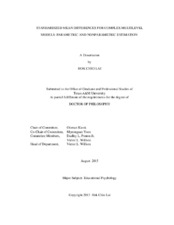| dc.description.abstract | This dissertation comprises three separate but interrelated manuscripts exploring methods for estimating the standardized mean difference effect size with several complex multilevel data structures. Multilevel modeling techniques are becoming more popular in handling data with multilevel structure in educational and behavioral research. However, unlike traditional single level research, methodological studies about multilevel effect size have been rare and those that have recently appeared had an emphasis on strictly hierarchical data structure.
In the first manuscript, I propose two methods for obtaining effect size in the two-level fully and partially cross-classified random effects models. Fully cross-classified data structure arises when individual observations are clustered by several levels that did not have a strictly hierarchical structure. For example, students may be classified by both their middle school and high school, but neither middle school is nested within high school nor vice versa. Partially cross-classified structure is a structure with an existing clustering in both the treatment and the control condition, but with the addition of an artificial clustering level only present in the treatment condition. The study will include derivation of the formulas, verification of their performances with Monte Carlo simulation, and illustration of their use with real data examples.
The second manuscript discusses two similar methods for obtaining effect size with two-level partially nested data. Partially nested data arises in randomized trials where the intervention creates artificial clustering, but no such clustering is present in the comparison group. In this manuscript I will present derivation of the formulas for the two methods, verify their performances with simulated data, illustrate their use with a real data example, and discuss the impact of failing to honor the partially nested structure on effect size estimates. The third manuscript explores the use of the bootstrap to estimate multilevel standardized mean difference. I will discuss various bootstrap methods, both parametric and nonparametric, to obtain effect size estimates for two-level studies. Their performances will be compared with analytical methods under conditions of excessive skewness and kurtosis in level-1 and level-2 random effects and varying design features. | en |


